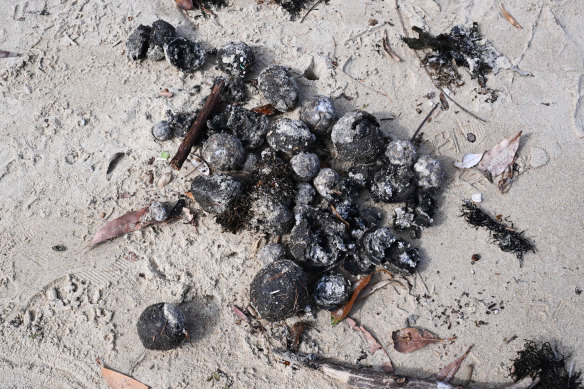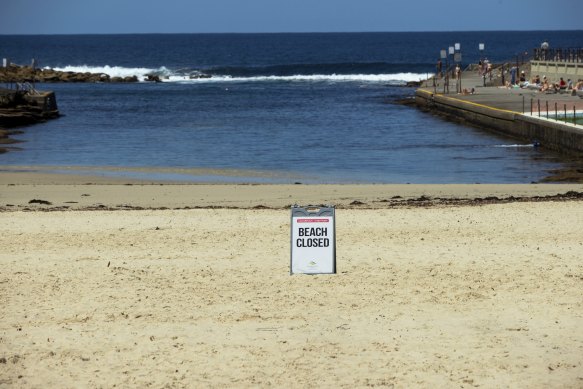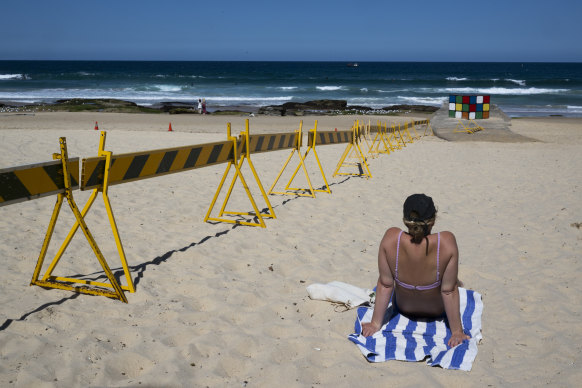This was published 9 months ago
Mission to track source of tar balls littering 11 Sydney beaches from Bondi to Botany Bay
By Caitlin Fitzsimmons
More Sydney beaches, including Bondi, have been closed after thousands of toxic tar balls were washed ashore, putting Nippers and Surf Life Saving events this weekend in jeopardy.
NSW Maritime is leading an investigation into the possible source of the pollution incident, which has affected nearly every beach in the eastern suburbs from Bondi to Little Bay.

Council workers in hazmat suits cleaning tar balls off Coogee Beach.Credit: Dominic Lorrimer
On Thursday, Waverley Council closed Bondi, Bronte and Tamarama beaches, while Randwick City Council closed the northern end of Maroubra and Clovelly. Coogee and Gordons Bay remain barricaded after they were closed earlier in the week.
The NSW Environment Protection Authority has confirmed the balls have also been found in debris at Congwong, Frenchmans, Little Bay and Malabar beaches.
NSW Maritime director Darren Wood said his agency had been working with the NSW Port Authority to investigate what can be seen offshore, after Coogee lifeguards on jetskis earlier reported seeing a small, dispersed oil slick in the ocean.
“We’ve had vessels out and we can’t see any more sheen on the water and also can’t see any more balls that are drifting in towards the beaches of our city, which is a good sign,” Wood said on Thursday.
Maritime would work with the Australian Maritime Safety Authority to identify the source of the contaminants, he said, including modelling that would factor in the currents and the wind to “work out whether it’s come from the south, north or east off the coast of NSW, to try and give us better indication on the likely source”.
At the same press conference, EPA executive director of regulatory practices and services, Stephen Beaman said specialists had collected samples for analysis to help identify the source of the pollution.
The balls that were washed up on Coogee Beach on Tuesday were the size of tennis or golf balls, while those washed up on beaches further north and south over following days were pea or marble size. Beaman said this suggested they were breaking up in the waves.

Preliminary testing revealed the dark spheres to be tar balls – a mixture of oil and debris.Credit: Janie Barrett
“The material is unusual, it’s quite fibrous … and some of it is wet and some of it is dry. Similar to council, we’ve found it has an oil front to it … and we’re using that hydrocarbon information to fingerprint the chemical analysis and help identify the source,” Beaman said.
“It’s a bit early to speculate about where the material came from. You can have oil come from boats. You can also have it come from land sources.”
The clean-up workers wore gloves on Wednesday, but upgraded to hazmat suits on Thursday. Beaman said it was a precaution and the risk was low.
Waverley Mayor Will Nemesh said in a statement the council would close its beaches as a precaution while the state government investigated. “The wellbeing of our community is paramount,” Nemesh said.

Clovelly Beach is closed after tar balls washed up.Credit: Dominic Lorrimer
Waverley Council confirmed Sculpture by the Sea, the art installation on the coastal walk from Bondi to Tamarama, would open on Friday as planned.
Randwick City Council contractors started a clean-up operation on Wednesday after preliminary testing revealed the mysterious grimy black spheres were “tar balls” – lumps of oil and debris.
Some petroleum products form tar balls when mixed with water, while others form slicks and dissipate. Whether it is washed up on the sand or falls to the sea floor, the substance is toxic and damages the ecosystem.
Randwick Mayor Dylan Parker said at an earlier press conference on Thursday that council was working hard to clean the beaches as soon as possible.
“It’s a beautiful, lovely spring day, and obviously, we want to get back as soon as possible onto the sand and in the water, and we thank the community for their patience with this situation,” Parker said. “We’re in close conversation with Nippers, Surf Life Saving and all beach users … but we don’t currently know what the situation will be on the weekend.”

The northern end of Maroubra Beach is closed because of tar balls, but Randwick City Council is monitoring the situation at the southern end.Credit: Louise Kennerley
Nippers, the surf lifesaving program for children, was due to start at Clovelly, Coogee and Bondi this Sunday, while the season kicked off at Maroubra, Tamarama and Bronte last week.
Nicole Cooney, lifesaving manager for Sydney Branch of Surf Life Saving NSW, said decisions about Nippers programs and any other events would be made on Friday on advice from the EPA and councils. However, if beaches closed, surf patrols would still monitor the water from off the sand.
“It’s definitely taken us by surprise,” Cooney said. “We’re used to having beautiful, clean beaches, so I can imagine that there’s a lot of concern about what’s happening.”
With Frances Howe
Members of the public who find these balls in other locations should call the NSW Environment Line on 131 555.
Start the day with a summary of the day’s most important and interesting stories, analysis and insights. Sign up for our Morning Edition newsletter.